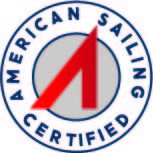
ASA 106, Advanced Coastal Cruising

Able to safely act as skipper and crew of a sailing vessel about 30 to 50 feet in length in coastal and inland waters, in any conditions.
| Prerequisites | and the ability to demonstrate competencies in all knowledge and skills elements of those Standards. |
|---|---|
| Study Materials |
KNOWLEDGE
1. Describe true and apparent wind.
2. Describe sailing forces using diagrams. Graphically find the center of effort and center of resistance of sails and keel, respectively.
3. Describe with the aid of diagrams the causes of lee and weather helm and methods of correcting them. Include the reasons for preference of slight weather helm, sail selection (including full sails or reefed sails), mast position and mast rake.
4. Describe sail shapes and sail interactions as needed for different wind strengths and points of sail. Describe the effects on sail shape and sail interactions when adjusting the following:
- Luff tension
- Outhaul
- Leech line
- Boom vang
- Backstay tension
- Jib fairleads
- Jib sheet tension
- Mainsheet
- Traveller
- Downhaul / cunningham
Weather
5. Describe how to use a barometer and a thermometer independently and concurrently to assist in predicting weather.
6. Describe cirrus, cirrostratus, altocumulus, stratocumulus, cumulonimbus and cumulus clouds and the weather expected to be associated with each.
7. Describe local weather in relation to thermal winds and prevailing winds.
8. Describe three sources of weather information available in the United States.
Seamanship
9. Describe the proper selection of sails on a given boat for all weather conditions and give reasons for the selection made.
10. Describe appropriate heavy weather precautions and describe how they are carried out, including:
- Sail changes
- Use of special equipment such as safety harness and sea anchor
- Doubling up of gear
- Special checks in areas liable to chafe
- Stowage of equipment above and below decks
- Additional checks on bilge condition
- Special arrangements for towing dinghy/tender (if used)
- Problems of fatigue
- Selection of clothing
- The need of at least two on deck at all times
11. Describe the steps to be taken by skipper and crew for “heaving to” and “lying a-hull.”
12. Describe the methods for rafting at anchor and the possible risks with day and night rafting.
13. Describe how to prevent the dinghy/tender from riding up and bumping the vessel’s hull while anchored at night.
14. Describe procedures for securing a boat overnight with one anchor and stern made fast to a dock or shoreline.
15. Describe two methods of using a second anchor to reduce swinging.
16. Describe four different methods of recovering an anchor that is fouled on the bottom.
17. Describe when and how to use a trip line and an anchor buoy.
18. Describe when and how to set an anchor watch and the responsibilities of the crew on watch.
19. Describe how to:
- Prepare a towing bridle
- Pass a tow to another boat
- Get underway with a tow and which speeds to use
- Avoid fouling the propeller
- Avoid danger of towline parting under stress
- Make proper lookout arrangements during towing
20. List 8 of the 16 International Distress Signals found in Rule 37 of the USCG Navigation Rules and Regulations Handbook.
21. Describe how the boat should be handled and what actions should be taken when the following emergencies occur while under sail:
- The boat is dismasted
- The boat runs aground on a lee shore
22. Describe how the boat should be handled and what remedial action should be taken when the following emergencies occur while under power:
- The engine cooling water fails to flow
- The engine fails in a crowded anchorage
- The engine fails in a busy channel
23. State the fuel tank capacity and range of a typical 40-foot cruising sailboat and the factors that could affect its range.
24. State the water tank capacity of a typical 40-foot cruising sailboat and the minimum water requirement per person.
25. Describe the skipper’s responsibilities and action for the following common courtesies and customs:
- Permission to board
- Permission and entitlement to come alongside
- Permission and entitlement to cross adjacent boats when rafted
- Rights of first boat at an anchorage
- Keep clear of boats racing
- Offering assistance to yachtsmen in trouble.
- Flag etiquette: National flag, Courtesy flag, Burgee/house flag, Dipping flag
- Checking of boat’s appearance (shipshape & Bristol fashion, no lines or fenders dangling over side)
- Duty to provide assistance at sea
26. List the documents required and the procedures followed when leaving and entering U.S. territorial waters.
Engineering
27. Describe appropriate measures for the following common engine problems:
- Stoppage in fuel line
- Burned and defective points
- Fouled spark plug/injector problems
- Carburetor icing (spring and fall sailing)
- Unserviceable starter
- Electrolysis
28. Describe when and how to carry out an oil change.
29. Describe the minimum pre-season inspection and maintenance for the following:
- Hull (including underwater fittings, electrical systems, painting, antifouling)
- Spars and rigging (including electrolysis)
- Sails
- Safety














